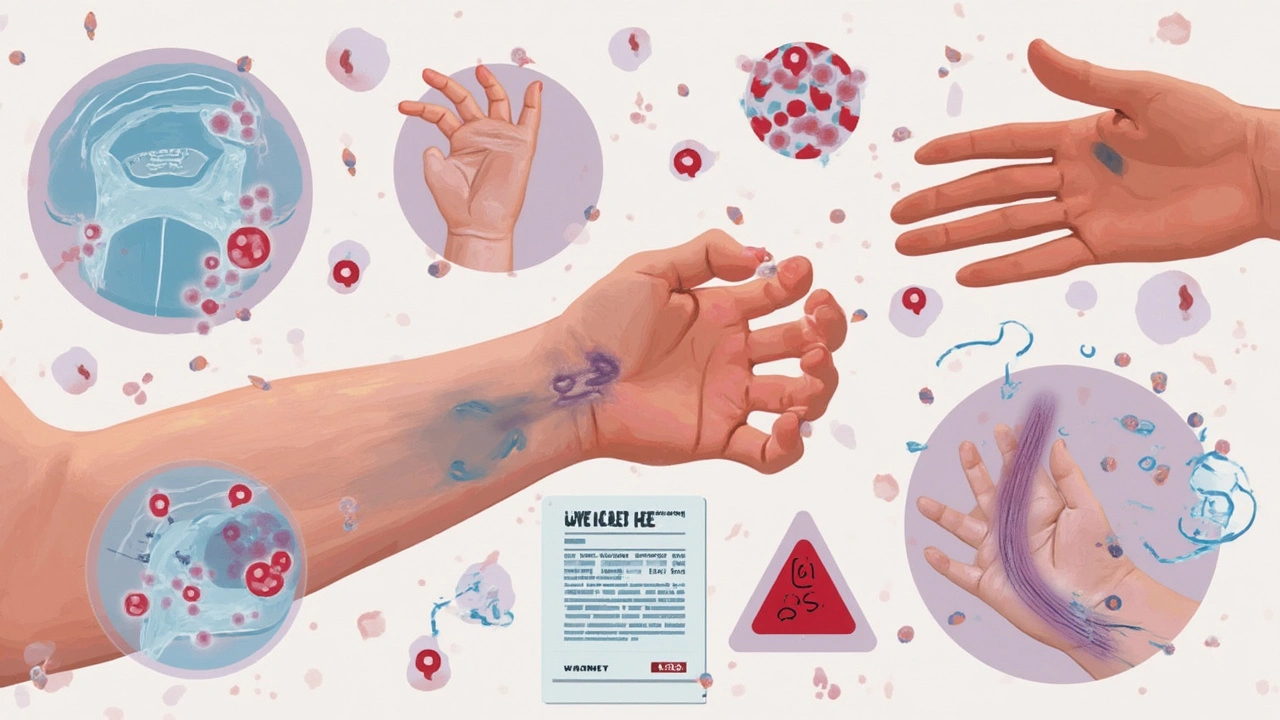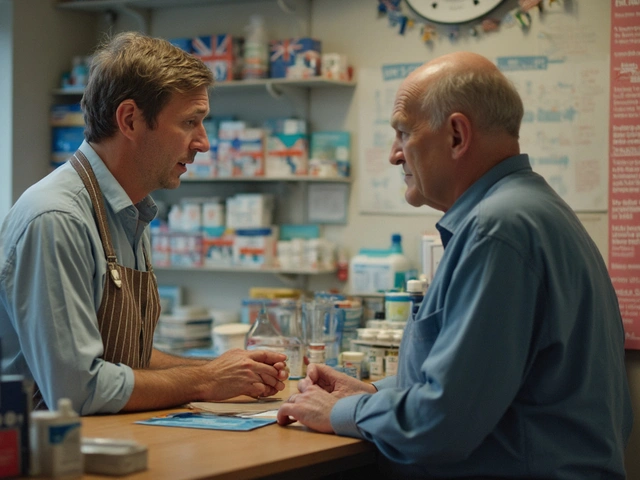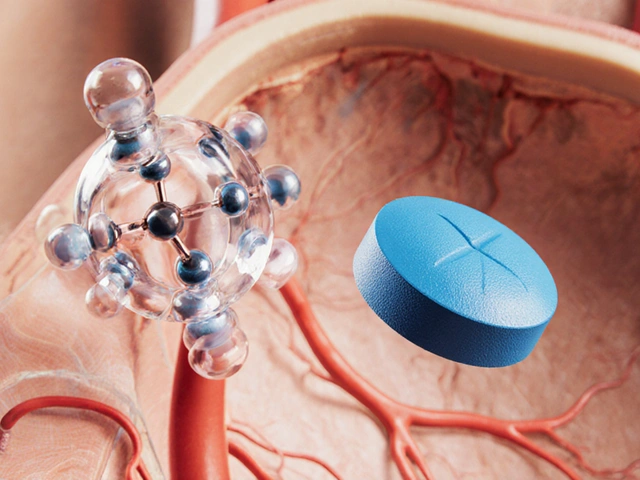Who knew that something as simple as a bruise could hint at something going haywire with your blood? Imagine your body’s clotting system like a sophisticated security team—it usually patches up leaks and keeps your blood from pouring out. But what happens when this team underperforms or goes into overdrive? Suddenly, small injuries might leave you bleeding too long, or “invisible” clots can threaten your brain, lungs, or even your heart. A quick scan of clotting disorder stories shows that even the healthiest-looking folks can end up in an emergency room, shocked by a nosebleed that won’t quit or a leg that suddenly swells up like an overinflated balloon. So why do these disorders happen, who’s at risk, and what can medicine really do about them? Let’s peel back the layers and see what’s actually going on inside our veins.
How Blood Clotting Works (When It’s Supposed To)
Before we jump into what can go wrong, it helps to see just how involved blood clotting is. Picture a cut: blood oozes out, but within minutes, it stops—thanks to a multi-step process called hemostasis. Here’s the play-by-play: blood vessels constrict to slow down blood flow; platelets, those tiny cell fragments, dash to the injury and stick together; then a bunch of proteins called clotting factors set off a chain reaction, creating a mesh of fibrin that forms a stable plug. Take one factor out or add an unwanted obstacle, and chaos can erupt.
Normally, this balance keeps us steady—if you bleed too much, you lose crucial nutrients and oxygen, and if you clot too much, you risk blocking major tissues and organs. This process is so crucial that just one mutation—like the well-known Factor V Leiden—might raise your risk of a dangerous clot by up to 4 times. On the flip side, people with hemophilia A, for example, lack enough of factor VIII, which means their blood can’t clot properly, sometimes with disastrous results even from small injuries.
Even modern medicine is learning from nature. Leech saliva, for instance, has chemicals that prevent clots, which doctors have used in microsurgeries where blood flow needs to be perfect. On the flip side, scientists are harnessing recombinant DNA to manufacture clotting factors—making them much safer for patients who once depended on sometimes-tainted blood supplies.
If you’re looking for a tip, remember this: unless you’re taking blood thinners or know you have a bleeding disorder, sudden unexplained bruises, swelling, or persistent nosebleeds should always get checked out. Early signs are easy to brush aside, but they can be the first clue that something much bigger is off.
Common Blood Clotting Disorders: The Basics
With more than a dozen different conditions falling under “clotting disorders,” the landscape is anything but simple. Here’s a rundown of the ones you’re most likely to hear about:
- Hemophilia: This group includes Hemophilia A (factor VIII deficiency) and Hemophilia B (factor IX deficiency). These are rare—about 1 in 5,000 male births for Hemophilia A. Women can carry the gene but usually don’t have symptoms.
- Von Willebrand Disease (VWD): The most common inherited bleeding disorder, VWD affects about 1% of the population. Milder forms might not show up until someone has surgery, dental work, or a serious injury.
- Deep Vein Thrombosis (DVT) / Pulmonary Embolism (PE): Both come from clots that form where you don’t want them—like in the deep veins of your leg. If a piece breaks off and moves to your lungs, that’s a pulmonary embolism, which can be fatal.
- Antiphospholipid Syndrome (APS): This one’s an acquired disorder, not inherited. It causes the body’s immune system to mess with clotting, often leading to blood clots, strokes, and even pregnancy complications.
- Disseminated Intravascular Coagulation (DIC): This is a rare but serious emergency, often triggered by infections or trauma, where your blood is making both too many and too few clots at once. It’s a medical rollercoaster with a high risk if not caught in time.
And get this—about 40% of hospitalized patients develop a blood clot, usually because they’re immobile or have surgery. That’s why doctors are so quick to get you up and moving after an operation. Meanwhile, millions walk around every day with genetic mutations that quietly raise their risk, never knowing until something goes wrong.
Kids, adults, athletes, and even pregnant women can all wind up facing a clotting disorder. Long flights, obesity, birth control pills, smoking, and certain cancers all boost the odds. It pays to know your family history—some disorders lie dormant for decades, only popping up after a trigger (like an injury or new medication).

Spotting the Symptoms: When Should You Worry?
Some signs of a clotting disorder are obvious, but many sneak under the radar. Sure, you’ll notice if you bleed too much from a simple scrape, but how about a DVT? The first hint might just be an achy, swollen calf.
Watch out for these symptoms:
- Unexplained heavy or frequent nosebleeds
- Bruising easily, especially without any real injury
- Lingering or severe bleeding after cuts, dental work, or surgery
- Blood in urine or stool
- Sudden severe headaches or vision changes (possible sign of a brain clot)
- Swelling, redness, or warmth in a leg or arm (possible DVT)
- Sharp chest pain, sudden shortness of breath (possible PE—call 911!)
- Prolonged menstrual bleeding (especially for women with VWD)
Here’s the wild part: up to 50% of DVT cases have no symptoms at all. A study from the University of Oxford in 2020 found that many people diagnosed with PE had no warning until they collapsed or developed chest pain out of the blue. This is why routine screening for high-risk groups—like people who just had major surgery or women on hormonal birth control—can be lifesaving.
Your primary care doctor won’t always spot these signs. If you have a family history or start seeing symptoms, push for a hematology consult. Modern blood tests can check for clotting factor levels, genetic mutations, or even markers of hidden clots in just a few hours. It’s not about paranoia—it’s about prevention. One quick test beats a hospital stay (or worse) any day.
Treatment Options: What Actually Works?
Treating blood clotting disorders means walking a tightrope—enough help to stop risky bleeding or dangerous clots, but not so much that you swing too far the other way.
The usual suspects for treatment include:
- Replacement therapy: For folks with hemophilia, missing factors can now be replaced with synthetic or recombinant proteins, often at home.
- Desmopressin (DDAVP): This synthetic hormone can boost levels of still-functioning clotting factors in mild VWD or hemophilia A.
- Anticoagulants: Medications like warfarin, heparin, or the newer DOACs (direct oral anticoagulants) help keep blood thin enough to avoid unwanted clots, but need careful monitoring to avoid bleeding.
- Antifibrinolytics: These meds help prevent clots from breaking down too quickly—useful for dental work or heavy periods with certain disorders.
- Immune suppression: Some autoimmune clotting issues (like APS) respond to steroids or other drugs that calm down the body’s mistake-prone immune system.
Then there are lifestyle tweaks. Compression socks, for example, help keep blood moving in people at risk for DVT. Staying hydrated and keeping active (even small leg exercises on airplanes) go a long way. For women, switching birth control types can cut clot risks; if a family member has a disorder, it’s vital to flag it before starting any hormone therapy.
Blood clotting disorders don’t have the same one-sized solution. Doctors might use gene therapy for rare cases (with promising results in some hemophilia studies as of late 2023), but most people rely on a mix of the above treatments, balanced with regular blood checks. Patient support groups are everywhere now—offering tips, new research, and even free exercise classes tailored to bleeding disorders.
And here’s a useful stat: early use of blood thinners after orthopedic surgery has slashed the rate of deadly DVTs from about 10% back in the ‘70s to less than 1% today. That’s the payoff of being proactive and informed.

Living With a Clotting Disorder: What You Can Do
Learning you have a clotting or bleeding disorder throws a wrench into life’s routine, but it doesn’t have to be the end of adventure. The first step is building a relationship with a hematologist—those folks are the real MVPs in keeping you safe. They’ll set up a detailed plan, which always includes knowing the warning signs to look for, carrying a medical ID, and having an emergency action plan.
If you’re a parent, make sure teachers or babysitters know what to do if your child gets hurt. For adults, work travel or vacations mean thinking ahead: pack extra medications, identify the closest hospital (just in case), and avoid risky activities like contact sports without medical advice.
Dental visits can become fraught. Dentists trained in bleeding disorders will coordinate with your doctor—timing meds, using special techniques to minimize trauma, and prescribing extra antifibrinolytics after big procedures. If you’re undergoing surgery, advocate for yourself: make sure your entire care team knows what you’re dealing with. It’s not overkill; it could save your life.
Here’s some actionable stuff you can do right now:
- Make a wallet card (or set up a medical alert on your phone) detailing your condition and treatments.
- Educate family and close friends about your disorder—they should be able to explain what to do in an emergency.
- Keep a regular supply of medications, especially if you travel or live far from a major hospital.
- Eat a balanced diet—too much vitamin K can mess with certain blood thinners, while alcohol and some herbal supplements can make bleeding worse.
- Stay up to date with annual checkups, and let your dentist or surgeon know about your condition before any procedure.
| Disorder | Approx. US Cases | Key Facts |
|---|---|---|
| Hemophilia (A+B) | Over 20,000 | More common in males; risk of bleeding into joints |
| VWD | 1 in 100 people | Often mild; women at greater risk of heavy periods |
| DVT/PE | 900,000 cases/year | About 1 in 4 sudden deaths from PE show no warning signs |
| APS | Est. 1-5% of population | Frequent miscarriages may be the only clue |
Every year, new advances (like gene-editing for hemophilia or wearable sensors that catch clotting changes early) are making these disorders less scary and more manageable. But knowing your risks, paying close attention to symptoms, and nodding along with your doctors instead of tuning out—that’s the stuff that keeps you healthy and out of the ER. Treat your clotting system like the underappreciated hero it is. Your future self will be glad you did.







11 Comments
Wow, this article really sheds light on something so easily overlooked in our health routines! Blood clotting disorders are like hidden ticking time bombs, right?
I'm glad it breaks down the symptoms too because sometimes it's hard to know when a bruise or a cut is actually serious. For people living with these disorders, knowing the newest treatments must be a massive relief :)
Does anyone here know if lifestyle changes like diet or exercise really make a big difference for managing these conditions? I'd love to hear real stories!
I totally agree!! It’s shocking how subtle the signs can be sometimes 🤯 Like, people might totally ignore little bruises or nosebleeds thinking it’s just normal 🙈
There’s so much anxiety around this which is valid but also why reading up on it helps a lot, y’know? The article’s tips are def handy, especially for us who might know someone at risk.
Also curious to know how accessible the new treatment options are in different places, especially for folks in rural areas or less developed countries 🤔
This topic's so important and frequently under-discussed! It's vital to point out that early detection can make a huge difference in outcomes, and symptoms vary widely.
Apart from obvious bruising or bleeding, symptoms like unexplained swelling or redness should raise red flags.
I've read about doctors recommending regular screening for individuals with family history. I wonder if that’s being adopted widely enough?
What do you all think about genetic testing as a preventative approach? Seems promising but also raises ethical questions.
Yes!!! This also brings to mind how important it is for patients to have a support system. I see so many people feeling isolated when dealing with chronic clotting issues.
The more we talk openly and share useful information, the less intimidating it becomes.
And advocates pushing for more research on treatments are essential too! These newer meds can dramatically improve quality of life if people get access to them.
Let's remember to encourage friends and family to get checked if they notice unusual symptoms.
It is of paramount importance to elucidate the biochemical pathways involved in coagulation processes to grasp fully the implications of these disorders.
The article adeptly covers vital points but could further cater to an audience seeking comprehensive mechanistic insights.
Moreover, advancements in pharmacological agents, such as direct oral anticoagulants, represent significant therapeutic milestones.
For the scientific community, continuous clinical trials and data transparency will enhance patient outcomes substantially.
Honestly, I found the part about symptoms super helpful. I never really knew why some people bruise so easily.
The reminder to pay attention to the body and not dismiss weird signs was 👏.
Also, it’s great that newer treatments can help prevent the worst outcomes. That gives hope.
Has anyone here been diagnosed or treated for clotting problems? What’s your take on living with it day-to-day?
Permit me to interject with a note on the ontological significance of blood-clotting anomalies in medical pathology.
The article did well to address symptomology and therapeutic strategies but left out a deeper epistemological inquiry into the nature of etiologies.
One must consider the profound impact of coagulation cascade dysregulation and its systemic repercussions, which arguably underpins a panoply of clinical phenomena.
Reflecting on this from a philosophical vantage point broadens our understanding beyond mere symptom description.
It’s really something how complex the human body is, right? Blood clotting can seem straightforward but when it malfunctions, it can lead to serious situations that are scary to think about.
The article’s practical approach really helps people recognize warning signs early.
I also appreciate the emphasis on recent treatment options — technology is moving fast in this field.
Still, I feel like awareness campaigns should be amped up because many people don’t take clot risks seriously until it hits close to home.
Honestly, the dramatics of blood clots are not to be underestimated. When the coagulation cascade misfires, it creates a labyrinth of clinical chaos that can devastate lives.
This article grazes the surface of such a complex disorder but fails to dive into the intricacies of molecular interactions and their catastrophic potential.
One cannot simply ignore the labyrinthine nature of thrombosis accompanied by embolic phenomena and their sinister, oft fatal consequences. The body’s defense mechanism can become a pernicious betrayer.
So yeah, if you’re not taking this seriously, you might as well be playing with fire.
Man, reading this makes me wanna shout from the rooftops how freaking important it is to know your body!
Blood clots can be sneaky, dude. One minute you think it’s just a tickle or a bruise, next thing you know it’s a hemorrhage or worse!!! 😱
Anyone else here got a crazy story about a clot messing with their life? I mean, this stuff isn’t just textbook info – it’s real and personal.
And yeah, those new treatments? Total game changers but still, prevention’s key!
This is such an informative post! I admire how it balances medical facts with approachable language, making a complicated subject more digestible.
I've personally witnessed how clotting disorders can impact families and am glad to see more awareness being raised.
One thing I’d highlight is the potential socioeconomic barriers to accessing treatment, which can be as challenging as the disorder itself.
Advocacy for equitable healthcare should walk hand in hand with spreading knowledge about these conditions.
Write a comment